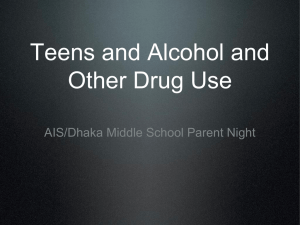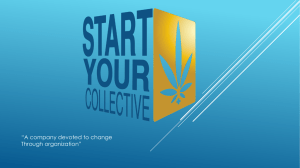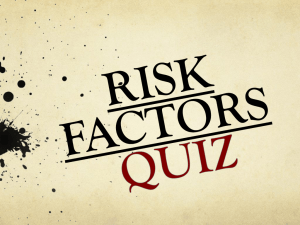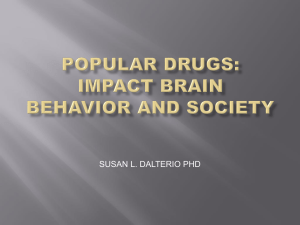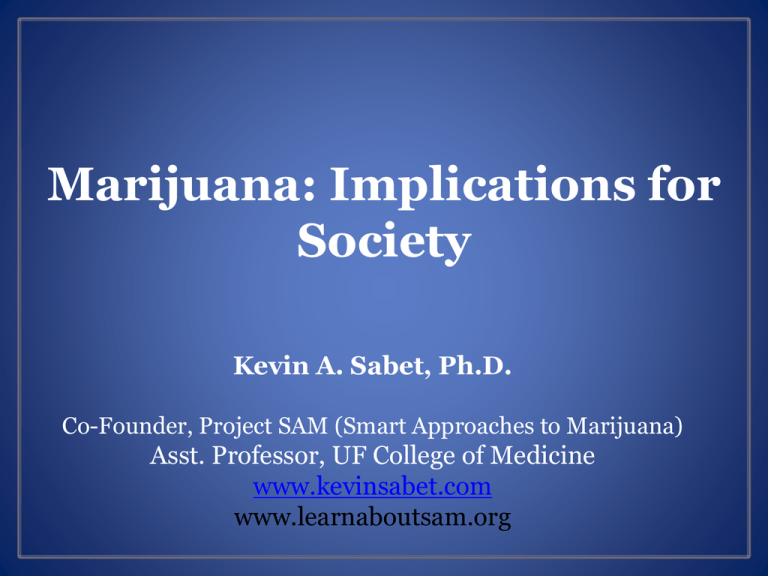
Marijuana: Implications for
Society
Kevin A. Sabet, Ph.D.
Co-Founder, Project SAM (Smart Approaches to Marijuana)
Asst. Professor, UF College of Medicine
www.kevinsabet.com
www.learnaboutsam.org
Marijuana
• The number and percentage of persons aged 12 or
older who were current marijuana users in 2011
were 18.1 million or 7% - similar to 2009 and 2010
rates, but higher than those in 2002 through 2008.
• From the late 1990s until the mid-2000s
marijuana use by adolescents (8th – 12th graders)
declined, however they started to rise again in
2006.
• In 2012, 22.9% of 12th graders used marijuana in
the past month – an increase from 18.8% in 2007.
Major Substances in General Population,
2011
Alcohol & Tobacco
Money Makers or Dollar Drainers
Alcohol
$200
bil.
$185
bil.
Costs
Revenues
Tobacco
$14
bil.
Kevin A. Sabet, Ph.D., www.kevinsabet.com
$25
bil.
Marijuana’s Health Effects
Most people who use marijuana once
will stop, and not become addicted.
1 in 6 kids who try marijuana
will become addicted.
For people who keep smoking marijuana,
the health harms
are underappreciated and costly.
Kevin A. Sabet, Ph.D., www.kevinsabet.com
Potency: Increased THC Content
in Seized Marijuana
PERCENTTHC FROM 1983 TO 2009
10%
9%
8%
7%
6%
5%
4%
3%
2%
1%
0
’85
’90
’95
’00
Sources: The University of Mississippi Potency Monitoring Project
Kevin A. Sabet, Ph.D., www.kevinsabet.com
‘05
282
Heroin
351
Stimulants
358
Hallucinogens
175
Inhalants
126
Sedatives
Dependence on or
Abuse of Specific Illicit
Drugs
Persons 12 or Older, 2008
4,199
Marijuana
1,716
Pain Relievers
Substance Abuse and Mental Health Services Administration. (2009). O$ ce of Applied Studies.
Treatment Episode Data Set (TEDS): 2009 Discharges from Substance Abuse Treatment Services, DASIS.
451
Tranquilizers
1,411
Cocaine
Long Term Effects of Marijuana
32
ESTIMATED PREVALENCE OF DEPENDENCE AMONG USERS
23
17
15
11
9
8
5
Tobacco
Alcohol
Marijuana
Cocaine
Stimulant
Analgesics
Psychedelics Heroin
Source: Wagner, F.A. &Anthony, J.C. From first drug use to drug dependence;
developmental periods of risk for dependence upon cannabis, cocaine, and alcohol.
Neuropsychopharmacology 26, 479-488 (2002).
Increased Marijuana Treatment
Admissions 1993 and 2007
PERCENT OFADMISSIONS
60%
1993 2007
50%
40%
30%
20%
10%
0
Alcohol
Cocaine
Heroin
Marijuana
Source: Treatment Episode Data Set, US Health and Human Services, 1993 & 2007
Kevin A. Sabet, Ph.D., www.kevinsabet.com
All or nothing?
Legalization vs. Incarceration-Only
Kevin A. Sabet, Ph.D., www.kevinsabet.com
Marijuana and Kids
The adolescent brain is especially
susceptible to marijuana use.
That means that when kids use, they have a
greater chance of addiction since their
brains are being primed.
If used regularly before 18, new research
shows that IQ drops by 8 points at age 38,
even when that person has stopped.
Kevin A. Sabet, Ph.D., www.kevinsabet.com
Chair, Patrick J. Kennedy
Launched January 10th, Denver
Over 5,000 press mentions
Public Health Board of Trustees
Kevin A. Sabet, Ph.D., www.kevinsabet.com
•To inform public policy with the science of today’s marijuana.
•To have honest conversation about reducing the unintended
consequences of current marijuana policies, such as lifelong
stigma due to arrest.
•To prevent the establishment of Big Marijuana that would
market marijuana to children — and to prevent Big Tobacco
from taking over Big Marijuana. Those are the very likely
results of legalization.
•To promote research of marijuana’s medical properties and
produce pharmacy-attainable medications.
One Week Later: Results
Over 5,000 media hits
Hundreds of supporting emails
Numerous endorsements
Political interest
Financial donations
Website with information and cites
Social Media: Twitter, Facebook
Future
Nationwide infrastructure to support local
partners in getting this message out
CADCA, NNOAC, California, Colorado, Ohio,
Michigan, Oregon, Washington, Rhode
Island, Massachusetts
“If Only We Treated It Like Alcohol…”
2.7 million
847,000
Arrests for alcohol-related crimes in
2008
(Does NOT include violence;
Includes violations of liquor laws and
driving under the influence)
Marijuana-related
arrests in 2008
Kevin A. Sabet, Ph.D., www.kevinsabet.com
Effect of Legalization on
Price & Consumption
RAND: Price Will Drop
More Than 80%
Consumption Will Increase
Tax evasion a major concern
Kevin A. Sabet, Ph.D., www.kevinsabet.com
What incentives do legal
corporations have to keep price
low and consumption high?
Alcohol:
“Drink Responsibly”
and Tax Low
Kevin A. Sabet, Ph.D., www.kevinsabet.com
Legalization:
Experience Elsewhere?
No modern nation has tried legalization,
though most Western countries do not
imprison people for simple marijuana
possession.
-
The Netherlands, Portugal, Italy use rates lower for some
drugs since 10 years ago; higher for others.
-
The Dutch experienced a three-fold increase in marijuana
use among young adults after commercialization
expanded.
Kevin A. Sabet, Ph.D., www.kevinsabet.com
Kevin A. Sabet, Ph.D., www.kevinsabet.com
Estimated Number of Sentenced Prisoners and Drug
Offenders Under State Jurisdiction, 1985 to 2009
Number of Sentenced Prisoners
1,400,000
All Offenses
1,200,000
1,000,000
800,000
600,000
400,000
200,000
38,900
148,600
224,900
263,800
251,400
Drug Offenses
1985
1986
1987
1988
1989
1990
1991
1992
1993
1994
1995
1996
1997
1998
1999
2000
2001
2002
2003
2004
2005
2006
2007
2008
2009
0
Source: Bureau of Justice Statistics, Prisoners in 2009 (December 2010); Prisoners in
1996 (June 1997).
6/2011
Kevin A. Sabet, Ph.D., www.kevinsabet.com
Underground Markets
and Crime
RAND: Mexican Drug Trafficking Organizations (DTOs)
earn 15-25% of revenue from marijuana.
It is highly likely that legalization
would not eliminate black markets for drugs.
State Legalization: 2-4% impact on DTO revenues
(California)
-
Most legalization proposals call for taxes on drugs,
which increases likelihood that markets will remain
endemic.
TCOs involved in numerous illegal trades
Kevin A. Sabet, Ph.D., www.kevinsabet.com
Taxes Necessary to Prevent a Price
Collapse Are Enormous
(Caulkins)
• Excise taxes create gray markets
• Most relevant metrics are
– Price per unit weight
– Price per unit volume
• Canada tried but had to repeal ~300%
excise taxes on tobacco
27
Medical Marijuana
Bypassing the FDA Process
Before FDAapproves a drug as medicine, testing is done to:
Determine the
benefits and risks
of the drug
Determine how it
may interact with
other drugs
Assure
standardization
of the drug
Determine the
appropriate
dosage levels
Identify and
monitor
side effects
Identify
safe drug
administration
Compassionate care or
increased access to marijuana?
>80%
• Most card holders in
CAand CO are white
men between the
ages of 17 and 35
• No history of
chronic illness
• History of Alcohol
and Drug Use
That doesn’t mean
that components
in marijuana do not
have medical
properties.
These are being
scientifically developed.
Compassionate care increased
access to marijuana?
<5%
• Only 10% of
card holders
are cancer,
HIV/AIDS, or
glaucoma
patients
• 90% are
registered for
ailments such
as headaches
and athlete’s
foot
Cannabis-Based Medicines
Sativex is in the process of
being studied
Approved in Canada and
across Europe
Administered via an oral
spray
Research on the efficacy of
cannabinoids is not focused
on raw/crude marijuana,
but in the individual
components that may have
medical use.
Kevin A. Sabet, Ph.D., www.kevinsabet.com
Let’s Not Go Back Here
The Liggett Group: “If you are really
and truly not going to sell [cigarettes] to
children, you are going to be out of
business in 30 years.”
R. J. Reynolds: “Realistically, if our
company is to survive and prosper, over
the long term we must get our share of
the youth market.”
Kevin A. Sabet, Ph.D., www.kevinsabet.com
Lorillard: “The base of our business is
the high school student.”
Phillip Morris: “Today's teenager is
tomorrow's potential regular
customer… Because of our high share of
the market among the youngest
smokers, Philip Morris will suffer more
than the other companies from the
decline in the number of teenage
smokers.”
There are alternatives…
Prevention
Treatment
Recovery
Smart
Enforcement
Kevin A. Sabet, Ph.D., www.kevinsabet.com
International
Efforts
Thank You!
Questions?
Email
kevinsabet@gmail.com




